-
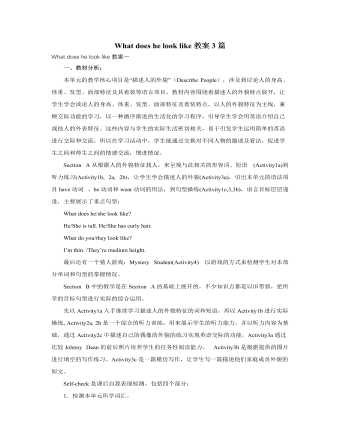
人教版新目标初中英语七年级下册What does he look like教案3篇
所需要用到的句子:Who is that?That is Jack. I like him.Why do you like him?I like him because he is interesting.Task 4: 设计理想中的人类Step one: 设计理想中的人类的外貌。把全班同学分成若干小组,学生可以边说边在纸上画出他们的模样。Step two: 设计理想中人类的性格。学生们可以把那些能描述性格的单词写在图画的旁边。Step three: 每组选出一名同学,其他同组同学提问,他作简单回答,并说明原因。所需用到的句子:What does he or she look like?He or she ...What is he or she like?He or she is ...Why?Because ...Task 5: 挑战性活动调查性格是天生的还是后天形成的,让每个同学回家去调查一下自己成长过程中性格是否有变化,具体是怎样的,为什么会这样? Teaching Aims:1. Enable students to have a general understanding of how to talk about people's physical appearance.2. Enable students to tackle some essential vocabularies and patterns about describing people. Provide them with necessary skills and methods.3. Create various chances for students to describe the persons they're familiar with, such as classmates, family members, teachers, idols, etc.
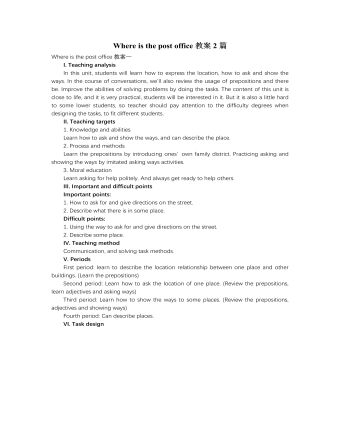
人教版新目标初中英语七年级下册Where is the post office教案2篇
Period 2 (3a----Section B 2c)Preview(Pre-task): Key points: What laAdd another information about their pen pals----their language on the cardnguage does she/he speak?She/He speaks....Does she/he have any brothers and sisters? Does she/he speak English?Preview(Pre-task): Add another information about their pen pals----their language on the cardKey points: What language does she/he speak?She/He speaks....Does she/he have any brothers and sisters? Does she/he speak English?Step 1 Revision1.Revisionand dictation of the new words 2.Revise the drills they learned yesterday.(by pairwork and grammar exercise)Step 2 Leading-inT has a conversation with one student. The conversation is following:---Do you have a pen pal?---Yes, I do.---What's your pen pal's name? ---His/Her name is....---Where is your pen pal from? ---He/She is from...---Where does he/she live? ---He/She lives in....---What language does he/she speak?He/She speaks...Write the new words on the Bb. They are following: EnglishChineseJapaneseFrenchStep 3 LearnLearn the new words with the whole class.Finish 3a with the students3b Pairwork T still does an example with one student Then the Ss practise in pairs. The example is following:--Curry Muray is my pen pal. He is from the United States.---What language does he speak?
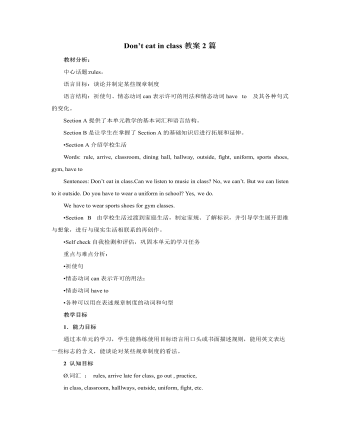
人教版新目标初中英语七年级下册Don’t eat in class教案2篇
Don’t fight. =You can’t fight. (板书,教读)教师把这些句子板书在黑板上,并请学生大声整齐地读祈使句和“can’t”句型,并让学生注意两种句型表达形式的不同和转换,“Don’t …=You can’t…”;并对学生说:These are our school rules. (板书,教读) You can’t break the school rules. Don’t break the school rules.(板书,教读)步骤3 :Practicea. T: Now, each of the students is breaking one of these rules.Please finish 1a.学生看图,完成1a的内容,检查答案并大声朗读校规。b. 听录音,完成1b,选出四位学生都违反了哪条校规;听之前,学生要读会英文名。c. 请两位学生朗读1c部分的句型;要求学生两人一组对话表演,SA扮演外校转来新生,SB告知本校校规。(学生可经过讨论,多说出他们想到的校规,不必只限于书上;教师应给予帮助)2) 第二课时(2a~4)步骤1 :warming up of revisionT: What are the rules at your school?学生使用“can”或祈使句表达各条校规;其中老师可引出“eat in the cafeteria outside”的表达。步骤2 :Practicea.T: Christina is an exchange student. She doesn’t know the rules. Let’s listen, what activities they’re talking about?学生听第一遍时,完成2a;第二遍时,完成2b;b. 请学生领读2c部分,看着2a完成的表格,理解2c活动的要求;分成小组针对2a进行问答;
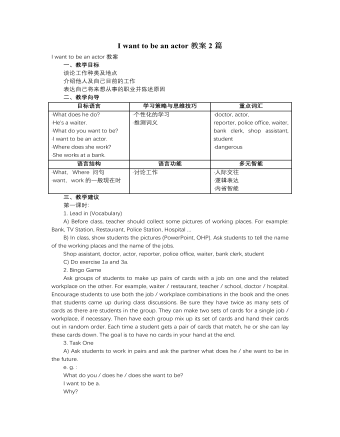
人教版新目标初中英语七年级下册I want to be an actor教案2篇
三、教学建议第一课时:1. Lead in (Vocabulary)A) Before class, teacher should collect some pictures of working places. For example: Bank, TV Station, Restaurant, Police Station, Hospital ...B) In class, show students the pictures (PowerPoint, OHP). Ask students to tell the name of the working places and the name of the jobs.Shop assistant, doctor, actor, reporter, police office, waiter, bank clerk, studentC) Do exercise 1a and 3a.2. Bingo GameAsk groups of students to make up pairs of cards with a job on one and the related workplace on the other. For example, waiter / restaurant, teacher / school, doctor / hospital. Encourage students to use both the job / workplace combinations in the book and the ones that students came up during class discussions. Be sure they have twice as many sets of cards as there are students in the group. They can make two sets of cards for a single job / workplace, if necessary. Then have each group mix up its set of cards and hand their cards out in random order. Each time a student gets a pair of cards that match, he or she can lay these cards down. The goal is to have no cards in your hand at the end.3. Task OneA) Ask students to work in pairs and ask the partner what does he / she want to be in the future.e. g. :What do you / does he / does she want to be?I want to be a.Why?Because it's (adj).B) Vocabulary: Section B, 1a4. Homework 1.2.
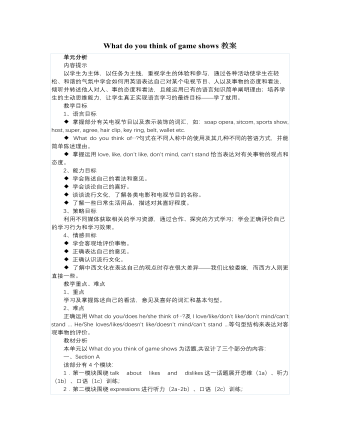
人教版新目标初中英语七年级下册What do you think of game shows教案
五、教学Section B-2c1. Pair work: What do you think of the belt/sunglasses/…? What does your father/mother/… think of your scarf/belt…?2. Group work(1). Teacher shows some different kinds of school uniforms (制服)and asks : “ What do you think of your school uniforms? If you have a chance to choose your school uniforms, what kind would you like to choose?”(2). Discuss in groups.(3).Get some Ss to report in class.说明:这一步旨在让学生运用已有的语言知识谈论对事物的看法和意见,并简单阐明理由,培养学生的主动思维能力和运用英语的能力。六、教学拓展调查电视节目的收视率任务:调查你周围的人对现在各种电视节目的反响。活动过程:1.教师布置任务,让学生调查周围的人(包括他的亲戚朋友和邻居)喜欢收看哪方面的电视节目。2.学生进行调查活动,运用本单元所学的句型What do you think of….? (Why?)What's your favorite game shows?What do you think of talk show?I doesn’t mind it.I like it.I love it.I can’t stand it.3.记录下排在前10位的TV Program,填写调查表,比较其收视率。
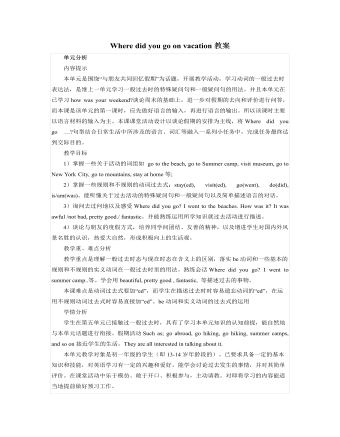
人教版新目标初中英语七年级下册Where did you go on vacation教案
句型: Where did you go on vacation? I went to summer camp.Did she go to Central Park?Yes,she did.No, she didn’t语法:一般过去时特殊疑问句、一般疑问句及肯、否定回答。课时安排4课时第一课时:Section A:la,1b,lc,2a,2b,2c 第二课时:Section A:3a,3b,4第三课时:Section B:1,2a,2b,2c第四课时:Section B:3a,3b,3c,4 and Self Check第一课时教学目标掌握描写假期生活的形容词。假期里自己所做事情的简单表达。谈论假期做的事情及当时情况。谈论假期时旅游的天气,旅游者以及食物等。教学过程一、导入播放一首英文歌曲:Let’s travel 说明:通过让学生听节奏欢快迪斯尼英语歌曲Let’s travel.引入本节课谈论的话题vacation and travel. 让歌曲使学生的思维活跃,增强课堂气氛,激发学生提高学习英语的兴趣。T:How is the trip ?Ss : It’s pretty good/ happy/exciting /relaxing/busy/dangerous/ fantastic说明:这个问题是为了操练形容词。建议让多个Ss作答。鼓励他们用不同的形容词。上述个别形容词本应在第二课时中出现,但可以在warming-up中第一次非正式出现。这些形容词也可在老师的评价语中适时出现,以加深学生对词汇的印象。
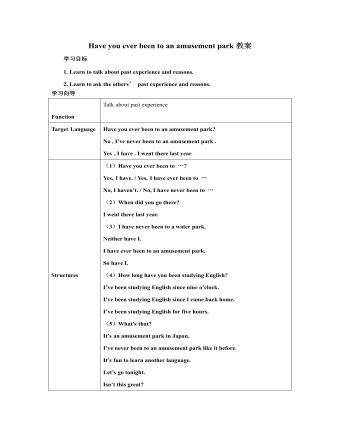
人教版新目标初中英语八年级下册Have you ever been to an amusement park教案
(1)Have you ever been to …? Yes, I have. / Yes, I have ever been to …No, I haven’t. / No, I have never been to …(2)When did you go there? I went there last year. (3)I have never been to a water park. Neither have I. I have ever been to an amusement park. So have I. (4)How long have you been studying English? I’ve been studying English since nine o’clock. I’ve been studying English since I came back home. I’ve been studying English for five hours. (5)What’s that? It’s an amusement park in Japan. I’ve never been to an amusement park like it before. It’s fun to learn another language. Let’s go tonight. Isn’t this great?space museum, amusement park, water park, South America, Peru, Holland, European culture, tour guide, flight attendant, musical instrument, more than, be from, get to, take lessons, neither, discover, graduate, change
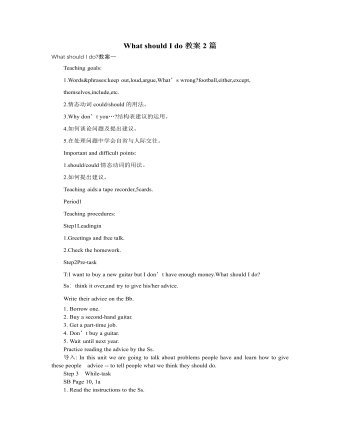
人教版新目标初中英语八年级下册What should I do教案2篇
说明:在帮Li Lei提建议的同时,教育学生如何学好英语。第三课时教学目标1. 语言目标:a) 词汇: Original, in style, haircut, the same as.b) 语言结构:My friend wears the same clothes and has the same haircut as I do.2. 能力目标:大多数学生能够谈论自己喜欢哪种服装,提高查找信息的能力。3. 情感目标:学会如何与朋友相处,要有自己对时尚的看法。教学重点掌握一些重要词汇。教学难点学会谈论问题,并能提出书面建议。◆教学突破首先针对Erin的问题,提出个人的建议,模仿2c部分的对话展开双人交际Pair-work;听老师诵读3a部分的信件,并找出LEFT OUT的问题所在;学生完成3b部分的内容,给Left Out提出书面的建议;学以口头形式提出自己目前存在的某个问题,讲给大家听,让同学们给自己提出一个建议,并作笔录;学生两、三个人分成一组,随意性地进行口语交际,谈论P14的第4部分的某个问题,相互交换意见。
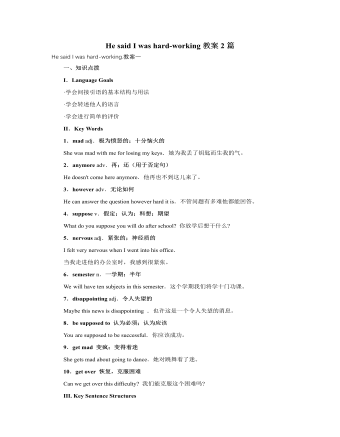
人教版新目标初中英语八年级下册He said I was hard-working教案2篇
This activity introduces some new vocabulary and provide oral practice using the target language.Task 1 . Ask four students to stand in front of the class, and the teacher asks them the following questions as a reporter.1.What are you going to do when you grow up?2.What are you going to do next week?3.What are going to do after school?The students will give different answers, then ask a good student to report what they said.I am going to e a doctor.What did she say?----------She said she was going to be a doctor.I am going to have a party on Friday night.What did he say?-------He said he was going to have a party on Friday night.I am going to do my homework.What did she say ?------ She said she was going to do her homework.I am going home after school.What did she say?-----She said she was going home after school.Say In this unit we are going to learn to use words like to report what someone said.Task 2. Read the instructions. Then ask a student to read the four questions. And write the words on the Bb. Explain what soap opera is.Task 3. Ask the students to Look at the pictures, point out the TV screens in the picture. Ask one girl to read what Marcia said.What did Marcia say? She said She said she was having a surprise party for Lana on Friday night. Repeat the other pictures in the same way.Activity3. Listen and number the pictures in activity 1a.
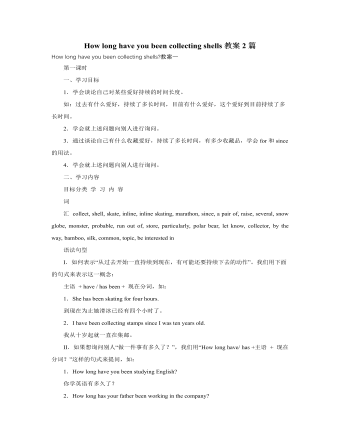
人教版新目标初中英语八年级下册How long have you been collecting shells教案2篇
Step Ⅱ Show the new words on the screen and teach the new words. Read the new words to students and ask them to repeat.Step Ⅲ 3aThis activity introduces new vocabulary and provides reading practice using the target language.In this activity first look at the four pictures.T: What can you see in the pictures?Ss: Four snow globes.T: Right. There are four snow globes in the pictures. And what are they?Ss: They are a monster, two polar bears, two penguins and a birthday cake.Write these words on the blackboard: snow globe; monster; polar bear; penguin and birthday cake. Read them to the class and ask students to repeat each one. Make sure students understand each word.Use a computer to show the E-mail message on the screen and read the message to students.Get students to read the e-mail on their own, and then draw lines connecting each snow globe and its description.Correct the answers.AnswersA line should connect each snow globe picture with the words that describe it in the letter.Step Ⅳ 3bThis activity provides writing practice using the target language.First review Activity 2a on Page 47.Then ask students to complete the message according to Activity 2a.Some partial sentences are given to students. Write about one person's collection.When students work, walk around the room checking the progress and offering help as needed.When they finish, ask some students to read their messages to the class.
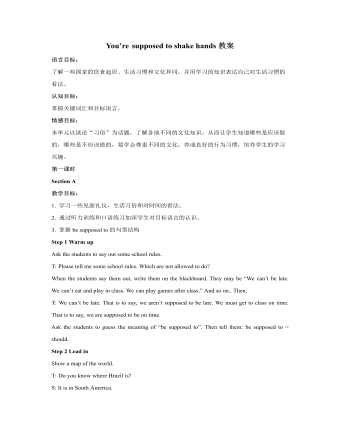
人教版新目标初中英语九年级下册You’re supposed to shake hands教案
教学目标:1. 掌握本单元一些重点词汇的写法和用法。2. 学会自如谈论餐桌礼仪。Step 1 RevisionAsk some students to retell the customs at the table in France in the passage in 3a.Step 2 Self checkPart 1. Fill in each bland with the correct word given. Students do the exercises by themselves at first. Then check the answers. Ask the students to comprehend the sentences and help them point out uses of some words, like “arrive (at / in) sw., spend time / money on sth , spend time / money (in) doing sth.”Part 2. Read about Fan Ling’s experience in a western restaurant. Understand the passage. Point out some key points in the passage.1. be / get used to doing sth. 习惯做某事2. begin with = start with 以….开头3. crowd v. 挤满,塞满 the crowd 人群 crowded adj. 拥挤的Then students discuss about how she would solve her problem. Ask some to share their stories with others.Part 3. Complete the crossword by looking at the sentences on the left. Then check the answers.
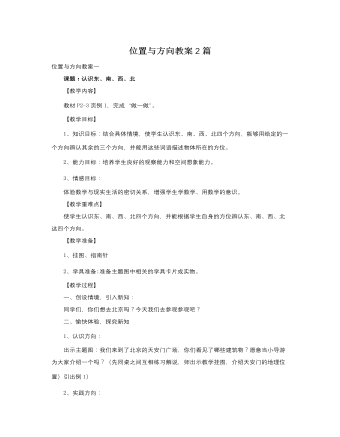
人教版新课标小学数学三年级下册位置与方向教案2篇
【教学目标】1、知识目标:结合具体情境,使学生认识东、南、西、北四个方向,能够用给定的一个方向辨认其余的三个方向,并能用这些词语描述物体所在的方位。2、能力目标:培养学生良好的观察能力和空间想象能力。3、情感目标:体验数学与现实生活的密切关系,增强学生学数学、用数学的意识。【教学重难点】使学生认识东、南、西、北四个方向,并能根据学生自身的方位辨认东、南、西、北这四个方向。【教学准备】1、挂图、指南针2、学具准备:准备主题图中相关的学具卡片或实物。【教学过程】一、创设情境,引入新知:同学们,你们想去北京吗?今天我们去参观参观吧?二、愉快体验,探究新知1、认识方向:出示主题图:我们来到了北京的天安门广场,你们看见了哪些建筑物?愿意当小导游为大家介绍一个吗?(先同桌之间互相练习解说,师出示教学挂图,介绍天安门的地理位置)引出例1)
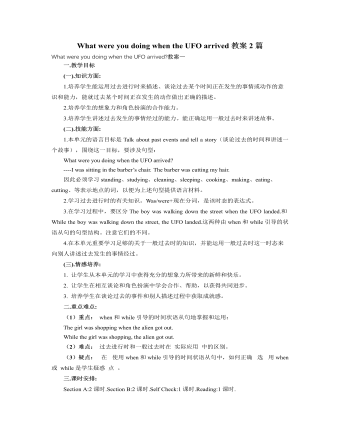
人教版新目标初中英语八年级下册What were you doing when the UFO arrived教案2篇
(一).知识方面: 1.培养学生能运用过去进行时来描述、谈论过去某个时间正在发生的事情或动作的意识和能力,能就过去某个时间正在发生的动作做出正确的描述。 2.培养学生的想象力和角色扮演的合作能力。 3.培养学生讲述过去发生的事情经过的能力。能正确运用一般过去时来讲述故事。 (二).技能方面: 1.本单元的语言目标是Talk about past events and tell a story(谈论过去的时间和讲述一个故事),围绕这一目标,要涉及句型: What were you doing when the UFO arrived? ----I was sitting in the barber’s chair. The barber was cutting my hair. 因此必须学习standing、studying、cleaning、sleeping、cooking、making、eating、cutting、等表示地点的词,以便为上述句型提供语言材料。2.学习过去进行时的有关知识。Was/were+现在分词,是该时态的表达式。 3.在学习过程中,要区分The boy was walking down the street when the UFO landed.和While the boy was walking down the street, the UFO landed.这两种由when和while引导的状语从句的句型结构。注意它们的不同。
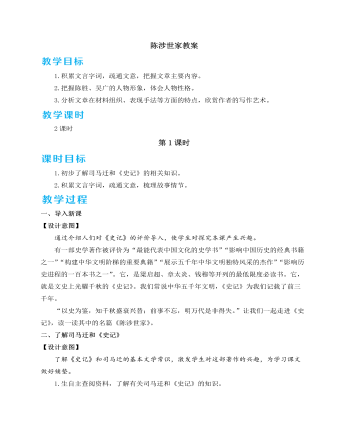
人教部编版语文九年级下册陈涉世家教案
1.王侯是一个地区的实际统治者,世代保有其国,对全国政局有一定的影响,故其传记称为“世家”。陈涉并非王侯,司马迁为什么把他归入“世家”?《史记》中人物传记分为三类,“本纪”记帝王,“世家”记王侯,“列传”记人臣,但这只是一个大略的划分,对于某些历史人物,作者有他特殊的考虑。陈涉就是一个特例。他出身低微,起义后虽自立为王,但为时仅六个月。之所以列入“世家”,是因为在秦王朝的严酷统治下首先发难,的确是非常之功。司马迁在这篇传记的最后写道:“陈胜虽已死,其所置遣侯王将相卒亡秦,由涉首事也。”可见司马迁看重的是功业,而不以成败论英雄。类似的例子有项羽,他并未统一称帝,但作者高度评价了他在反秦斗争中的领导作用,把他列入“本纪”。2.本文是长篇节选,在结构上具有怎样的特点?
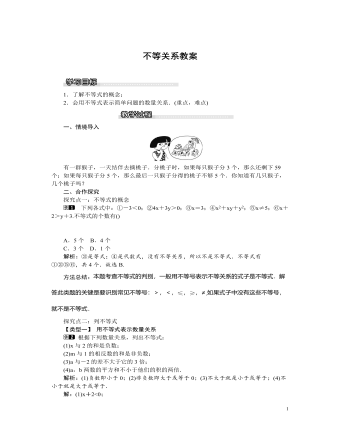
北师大初中八年级数学下册不等关系教案
A.20x-55≥350 B.20x+55≥350C.20x-55≤350 D.20x+55≤350解析:此题中的不等关系:现在已存有55元,计划从现在起以后每个月节省20元.若此学生平板电脑至少需要350元.列出不等式20x+55≥350.故选B.方法总结:用不等式表示数量关系时,要找准题中表示不等关系的两个量,并用代数式表示;正确理解题中的关键词,如负数、非负数、正数、大于、不大于、小于、不小于、不足、不超过、至少、至多等的含义.三、板书设计1.不等式的概念2.列不等式(1)找准题目中不等关系的两个量,并且用代数式表示;(2)正确理解题目中的关键词语的确切含义;(3)用与题意符合的不等号将表示不等关系的两个量的代数式连接起来;(4)要正确理解常见不等式基本语言的含义.本节课通过实际问题引入不等式,并用不等式表示数量关系.要注意常用的关键词的含义:负数、非负数、正数、大于、不大于、小于、不小于、不足、不超过,这些关键词中如果含有“不”“非”等文字,一般应包括“=”,这也是学生容易出错的地方.
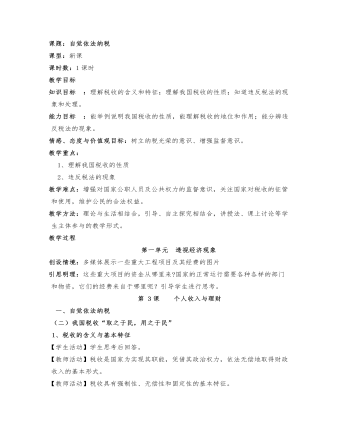
八年级思想政治下册自觉依法纳税教案
一、自觉依法纳税(二)我国税收“取之于民,用之于民” 1、税收的含义与基本特征 【学生活动】学生思考后回答。 【教师活动】税收是国家为实现其职能,凭借其政治权力,依法无偿地取得财政收入的基本形式。 【教师活动】税收具有强制性、无偿性和固定性的基本特征。[1]强制性:不管你愿意还是不愿意,都必须交税。[2]无偿性:交了税,没有补偿,更不会返还。[3]固定性:征税是有标准的,不是无止境的,按标准收到一定数量即算完成纳税。 2、税收的性质 【教师活动】展示多媒体图片,观察税收性质是什么? 【学生活动】分析图片,税收的性质。 【教师活动】每个人都与税收紧密地联系在一起,我们天天享受到的公共物品,无不有赖于税收。接受教育要有学校,看病要有医院,出行要有道路,保障国家安全要有国防,防洪、发电要有水利工程,这些都要依靠国家的税收来为公众提供公共服务。 【教师活动】播放国家免费为新冠肺炎患者治疗的视频。 【教师活动】劳动人民是税收的最终受益者,我国的税收是取之于民、用之于民的新型税收。
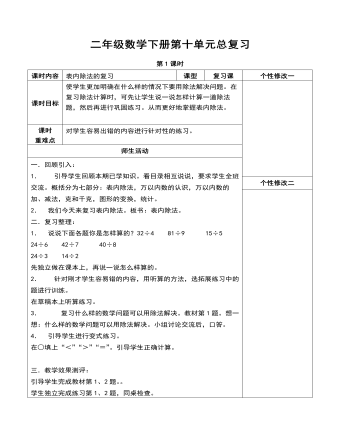
二年级数学下册第十单元总复习教案
1、复习万以内数的认识。 请同学们先来回忆一下,我们学了万以内数的哪些知识? 回忆学了万以内数的数数、读数、写数、数的组成、数位的含义、数的顺序和大小比较、近似数以及整百、整千数的加减法……2、下面先请大家独立做教材第3题,然后集体订正。 指名让学生说一说是怎么做的?3、写一写,再读一读。① 千位上是2个千、百位上是5个百、个位上是6个一。② 二千五百零六。4、 下面复习用计数单位表示数,独立完成书上第4题,想一想是怎样做出来的。5、 复习近似数。请同学们看教材第5题,找出这段文字中哪些数是近似数?并画出来。再请同学回答。
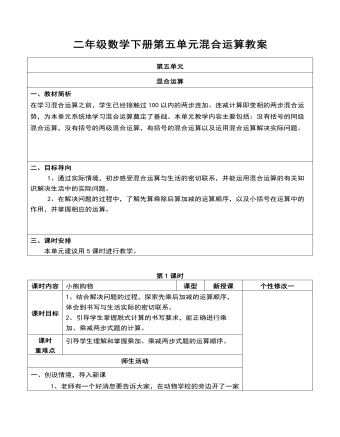
二年级数学下册第五单元混合运算教案
一、创设情境,导入新课 1、老师有一个好消息要告诉大家,在动物学校的旁边开了一家超市,森林里的小动物们都去那儿购物。今天,小熊哥俩正在商店里购物呢!你想看看吗? 2、教师出示情境图,教师板书课题:小熊购物二、自主探究新知 1、解决第(1)个问题“小熊该付多少钱?” 1)“仔细观察情境图,你能发现哪些数学信息?”,教师总结重要数学信息。 2)“ 大家看小熊说的话,你能提出什么问题?” 引出“小熊该付多少钱?”这个问题。 3),教师巡视搜集学生出现的不同做法 4)展示学生作业,并引导其他学生质疑“第二个算式是什么意思?”若学生中不出现第二个算式,教师引导学生将两个算式合在一起。 5)脱式计算:根据学生列出的算式,教师结合算式指导学生进行脱式计算,规范学生的书写格式。
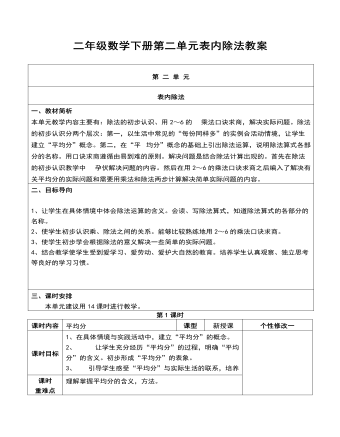
二年级数学下册第二单元表内除法教案
一、教材简析 本单元教学内容主要有:除法的初步认识、用2~6的 乘法口诀求商,解决实际问题。除法的初步认识分两个层次:第一,以生活中常见的“每份同样多”的实例合活动情境,让学生建立“平均分”概念。第二,在“平均分”概念的基础上引出除法运算,说明除法算式各部分的名称。用口诀求商遵循由易到难的原则。解决问题是结合除法计算出现的。首先在除法的初步认识教学中 孕伏解决问题的内容。然后在用2~6的乘法口诀求商之后编入了解决有关平均分的实际问题和需要用乘法和除法两步计算解决简单实际问题的内容。
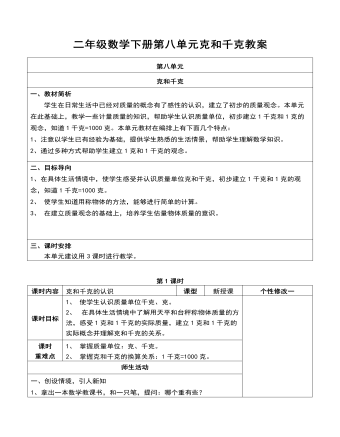
二年级数学下册第八单元克和千克教案
1、拿出一本数学教课书,和一只笔,提问:哪个重有些?2、肯定学生的回答,并让学生“掂一掂”,然后让学生说说有什么样的感觉。3、从刚才的实践得出结论:物体有轻有重。板书课题。二、观察、操作领悟新知1、出示主题挂图,物体的轻重的计量。观察主题挂图。(1、)请同学们观察一下,这幅图画的是什么?(2、)这幅图中的小朋友和阿姨在说什么?(3、)前几天,老师让大家广泛收集、调查我们日常生活中常见物品的质量,我们现在来交流以下好吗?表示物品有多重,可以用克和千克单位来表示。(4、)在学生说的同时,老师拿出有准备的东西展示。





















